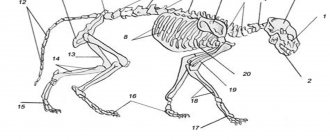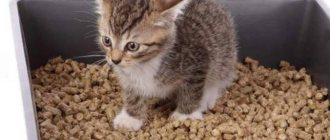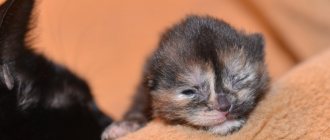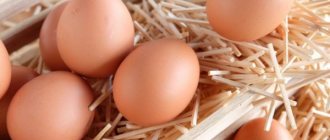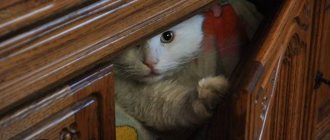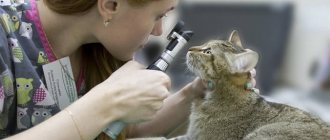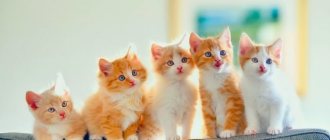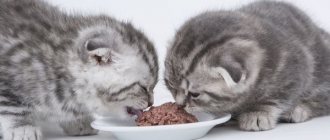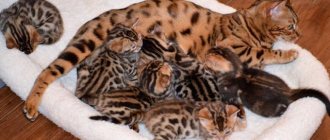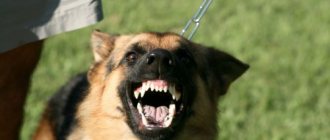Most often, feeding the babies is the responsibility of the breeder, but sometimes the owner takes care of these problems. Having picked up an animal on the street or separated it from its mother too early, you will have to figure out how to teach the kitten to eat on its own. By studying the basic rules for introducing complementary foods and eliminating prohibited foods, you can easily raise a healthy pet.
How do newborn kittens feed?
Newborns are fed by the mother, as her colostrum is the most nutritious and safest feeding option. Alternative feeding methods are only permissible if the mother cat does not have breast milk.
Mother's milk
In addition to the nutrients needed for normal growth, breast milk imparts passive immunity. It protects newborns until the first vaccination, that is, up to 2-2.5 months.
This feeding method is the most optimal, since human participation is minimized. It is important for the owner to care only about the quality of the new mother’s nutrition.
Artificial feeding
Before starting artificial feeding, it is better to consult a veterinarian. The stomach of newborns is very small, so it is important to correctly calculate the daily dose.
Babies are fed special formulas that imitate cat's milk. Consumption of goat and cow's milk is not recommended, as these types do not contain the required amount of nutrients and can cause digestive problems.
In the first 2 weeks, furry pets are given warmed milk from a pipette 8 times a day every 2-3 hours. At week 3, they are accustomed to the nipple, reducing the number of feedings to 7 and introducing a five-hour night break.
Regular food
A small kitten is in many ways similar to a tiny human child, although some may consider such a comparison to be incorrect. Why is such an allegory given here? People teach their children to eat gradually, without haste, but the child still continues to eat mother’s milk or special formulas. You need to behave in exactly the same way with a small kitten. If there is no cat, and the kitten is very tiny, less than three weeks old, then you will have to feed it using a baby bottle or pipette.
At what age do kittens begin to eat on their own?
Some animals can allow cubs to breastfeed for up to 6 months, but most often breastfeeding stops at 3 months. Despite this, the first complementary foods are introduced at 1-1.5 months. By this age, the amount of breast milk decreases, and the cat begins to avoid the cubs and more often get out of her house. The most responsible parents show the location of the kitchen, showing their offspring their own bowls.
Due to lack of food, babies begin to look for other sources of nutrition and respond positively to complementary foods. They gradually develop teeth that help them chew harder foods.
Rules for introducing complementary foods
Sudden variety is dangerous for a one-month-old baby, so all new products are introduced gradually. Give him no more than one new food every day. This will help track an allergic reaction.
The first complementary foods are given directly from the finger. With the approval of the mustachioed pet, a small portion is mixed into the already familiar food.
At first, all products are pureed. Solid foods are served only after baby teeth appear, that is, at about 2 months. At this age, in addition to slimy porridges, kefir, soft cottage cheese and pureed boiled vegetables, you can add finely chopped meat (lean beef, chicken, turkey, rabbit). Before serving, it must be thoroughly frozen and boiled.
All food should be warm, since too high and low temperatures are harmful to the mucous membranes of the esophagus, stomach and intestines. At first, it is recommended to avoid loud noises in the kitchen. In a calm environment, the baby will be more focused, and therefore will quickly begin to eat on his own.
Additional Tips
Kittens at a young age eat small amounts of milk, so a regular plastic lid for cans would be a convenient container for them. It is difficult for a kitten to learn to feed itself in a large bowl, since the milk is distributed unevenly, and the animal simply bathes in it.
Milk for feeding should be at room temperature, as too cold or too hot a formula can adversely affect the health of a small pet. You can heat the product using any available methods (microwave, regular heating), but it is important to check the degree of heating itself (no more than 37 degrees).
At first, a pipette, a syringe, or a container for nasal drops are used as a feeding device for a newborn kitten. The container must be thoroughly washed and sterilized before first use.
A kitten that lives with its mother quickly gets used to eating from a bowl after the cat, since she independently ensures that the offspring acquires all the necessary skills. Therefore, it is better to adopt a small pet after two months of age, when it is completely ready for life in a new home and easily adapts.
What, how much and how often to feed a kitten
Small pets are characterized by rapid growth. On average, they gain 10 g every day. Changes must be constantly monitored to prevent stunting. With proper and balanced nutrition, the likelihood of developmental problems is minimal.
At 1.5 months
At this age, breast milk is still the mainstay of the diet. Additionally, the menu includes:
- rice or semolina porridge, which promotes weight gain;
- boiled chicken or quail yolk;
- vegetable puree from zucchini, cabbage or pumpkin;
- chopped meat;
- low-fat cottage cheese, kefir and yogurt.
Food is given 7 times a day, excluding night feedings. This helps improve your sleep schedule. A single serving should be approximately 17 g, and a daily serving should be 120 g.
At 2 months
When teething, the diet is supplemented with solid food: finely chopped pieces of meat and fish. All of the above products are thoroughly boiled and removed from the bones. The number of feedings is reduced to 6, and the volume of the daily portion is increased to 150 g.
With the advent of solid food, you can refuse minced meat. Only liquid porridges and fermented milk products, which make up 50% of the entire diet, are preserved.
At 3 months
From 3 months to six months there is a rapid growth phase. Muscle mass and skeleton are actively developing. The portion is calculated based on the weight of the animal. For every kg there should be 200 g of food. The baby is fed 5 times a day. After vaccination, it is allowed to introduce boiled offal that has been deep frozen.
The amount of fermented milk products is reduced to ¼ of the diet, and milk is eliminated completely. The animal is given larger pieces of meat and the first raw vegetables (carrots, zucchini). When cooking porridges, reduce the amount of liquid, making them thicker.
Please note that, in addition to natural food, dry food is also acceptable. Choose lines designed specifically for kittens, but no less than premium ones. They are distinguished by their high calorie content and fortified composition. All standards are indicated on the packaging. Before the cloves appear, the granules will have to be soaked in warm water or milk formula.
Age 0 to 3 weeks
At first, babies are entirely dependent on their mother, but if the cat does not have enough milk or the kittens are orphaned for some reason, the person takes on the function of nurse.
The most important point in caring for newborn kittens is the feeding regimen, as well as the portion size and composition of the mixture. Negligence in preparing a diet can lead to a malfunction of the digestive tract and an irreparable deterioration in the baby’s vital signs.
You can determine that kittens do not have enough food based on several signs:
- babies gain weight poorly or not at all;
- the whole body looks narrow and thin, the tummies are sunken;
- kittens are restless, make sharp whining sounds, but subsequently become apathetic, weakening every hour;
- the skin loses its elasticity due to progressive dehydration, muscle tone weakens, and vital processes stop.
To feed infant kittens, choose one of the cat's milk substitutes, or prepare a suitable mixture at home.
Cat milk replacers
Specialized dry mixtures are sold in pet stores and veterinary pharmacies; they are balanced in composition and contain all the necessary nutrients. They are suitable for kittens of all breeds and do not require much time to prepare: just dilute the required amount of the mixture with warm water and stir well.
It is preferable to choose products from well-known global manufacturers that produce premium and super-premium food, for example:
- Beaphar Kitty-Milk;
- Royal Canin Babycat Milk;
- Nutri-Vet Kitten Milk;
- Kittenmilch cdVet.
It is not recommended to buy:
- low-quality animal formulas with added starch;
- milk substitutes with fat content below 8%;
- food for human infants containing sugars and a completely different set of ingredients.
Self-cooking
Food suitable for feeding infant kittens can also be prepared at home. Caring owners can offer several proven recipes:
- To 200 g of whole cow's milk add 200 g of goat's milk, as well as 2 egg whites, whisking thoroughly in a bowl.
- Pour ½ tsp into 100 ml of goat milk. refined corn oil and half a raw egg yolk, stirring until smooth.
- Add ¼ tsp to 250 ml of hot cow's milk. fresh bone meal, 50 ml of natural condensed milk without sugar and 25 ml of boiled water. The resulting mixture is filtered and cooled.
- Add 1 drop of Trivit liquid vitamins to 100 ml of natural coffee cream (fat content 9%).
Portion calculation
The serving size for each feeding is calculated based on the age and weight of the baby:
- from 0 to 4 days – 60 ml of mixture per 200 g of live weight;
- from 5 to 13 days – 76 ml/200 g body weight;
- from 14 to 24 days – 92 ml of mixture per 200 g of weight;
- from 25 to 30 days – 106 ml per 200 g of weight.
Basic feeding rules
The owner should adhere to a number of rules:
- It is necessary to feed kittens every 2 hours, and if there is a lack of mother's milk, 5-6 feedings per day are sufficient;
- a fresh portion is prepared from powdered milk replacer each time, and the “homemade” mixture of natural products is stored in the refrigerator for no more than 2 days;
- food is served to babies warm from a bottle with a narrow nipple or through a pipette (with a hole) placed on a syringe;
- nipples, bottles and pipettes are thoroughly washed and dried after each feeding.
How to teach your baby to eat and drink from a bowl
At a young age, animals often copy the behavior of more experienced relatives. Their main authority is their mother. If a cat shows interest in raising offspring, then she herself teaches him all the basic skills. Otherwise, the owner will have to figure out how to teach the kitten to eat on its own.
For bowl training, use the following tips:
- Separate the cubs from their mother 2 hours before feeding. This will help them work up an appetite.
- Pour warm milk (36 °C) into a tablespoon and offer your pet a try. You can also use a regular finger and dip it in milk.
- If your pet drinks or licks the milk offered, pour a new portion into his bowl. Perform actions right in front of your baby. Having seen and smelled familiar food, he will definitely show interest in the container.
- Don't poke the animal's nose. This can cause unpleasant associations due to the increased sensitivity of the organ. Also, sudden inhalation of liquid can cause aspiration pneumonia.
- If the pet refuses to lap, repeat the second step. Stick your finger in the bowl and offer to try it again. Here you need to be patient. Soon the baby will understand what they want from him and will begin to eat himself.
During the meal, stop attempts to climb into the bowl with all four paws. If you frequently turn the container over, choose a more stable model. Do not use detergents that have a strong odor. Accompany every trip to the kitchen with the word “eat”, reinforcing positive associations. At first, be sure to return the pet to its mother for additional feeding.
Possible problems
In addition to observing the norms and frequency of feedings, it is important to avoid prohibited foods. They can lead to disturbances in the gastrointestinal tract, accompanied by complete refusal of food. An animal left without food for a long time may die.
Refusal to eat
If feeding problems occur in newborns, they must be checked by a veterinarian. Pathological reasons for refusing food at such an early age include:
- hypothermia, that is, low body temperature;
- intrauterine infection with leukemia, chlamydia or other dangerous diseases;
- too low weight associated with pathologies of the placenta;
- any intrauterine development disorders;
- internal injuries;
- hemolysis of newborns, accompanied by the destruction of red blood cells by antibodies supplied with colostrum.
If the baby has always had a good appetite, but increasingly refuses to eat after the introduction of complementary foods, then the problem may lie in:
- Stress
. Separating from the mother too early and abruptly switching to new food is harmful for the animal.
- Allergies
. An allergic reaction is accompanied by rashes, hair loss, redness of mucous membranes and other alarming symptoms. To normalize the condition, the allergen is excluded from the diet.
- Gastrointestinal disorder
. If vomiting and diarrhea occur, have your pet checked at a veterinary clinic. In addition to the usual eating disorder, worms or other parasites may be found in the body.
- Incorrectly selected dishes
. The pungent smell of plastic and the presence of dirt are unacceptable for clean representatives of the cat family.
If any alarming symptoms appear, be sure to contact your veterinarian. Kittens are more vulnerable than adult pets, so any delay can cost them their lives.
Prohibited foods
The list of prohibited foods includes everything that appears on the human table: spices, pickles, smoked foods, fried foods, flour and sweets. You should also exclude:
- pork, often contaminated with worms and causing obesity;
- millet and pearl barley porridge, poorly digestible in the stomach;
- grapes (raisins) and mushrooms that can lead to poisoning;
- garlic and onions, which contribute to the development of anemia;
- sorrel, which causes an acute form of gastritis;
- any bones that injure the esophagus and intestines when swallowed;
- a family of legumes that cause increased gas formation.
Milk is removed from the diet by the age of one year. Closely monitor your pet's reaction to this product. If lactose intolerance develops earlier, then it is not necessary to wait a year. This condition is accompanied by severe bloating and diarrhea, so it is difficult to miss.
Prohibited foods for the diet
There are foods that should not be on a kitten's menu. Experienced specialists give several recommendations:
- raw cow's milk is poorly absorbed in the digestive system of babies;
- when milk is diluted with water, its nutritional value decreases, the pet will not receive enough microelements;
- fermented milk drinks in the form of yoghurt, kefir, fermented baked milk are not digested in the gastrointestinal tract of kittens;
- harmful products for children are sausages and cheeses;
- Infection with parasites can occur from raw minced fish.
Drinking regime
The water requirement for kittens is higher than for adult animals. They should always have fresh bottled or filtered water in their bowl. It will have to be changed several times a day. Otherwise, your pet may refuse to drink and suffer from dehydration.
Choose a wide bowl that won't get in the way of the tendrils. The safest materials include ceramics and glass. They do not give off an unpleasant odor and collect less bacteria.
After learning the tips on how to teach a kitten to feed itself, you will easily achieve results. During training, try not to put pressure on your pet, giving him freedom of action. Remember that if you refuse food for a long time, it is better to consult a doctor.
The article is for informational purposes only. Contact your veterinarian!
A few necessary recommendations
It is difficult for your kitten to feed himself if the dishes are awkward or large, so you should choose dishes that are the right size and that are stable on the floor. This way the baby will feel more comfortable and will eat more willingly.
Be sure to read:
When kittens open their eyes depending on the breed: features, why it doesn’t happen on time
Don't forget the following simple rules:
- A saucer of water should be placed near the bowl of food.
- You cannot force a kitten to eat.
- Do not mix dry food with regular food. This can only be done when switching from one food to another.
On a note! The kitten will refuse food that is too hot or, on the contrary, cold . Food should be at room temperature.
